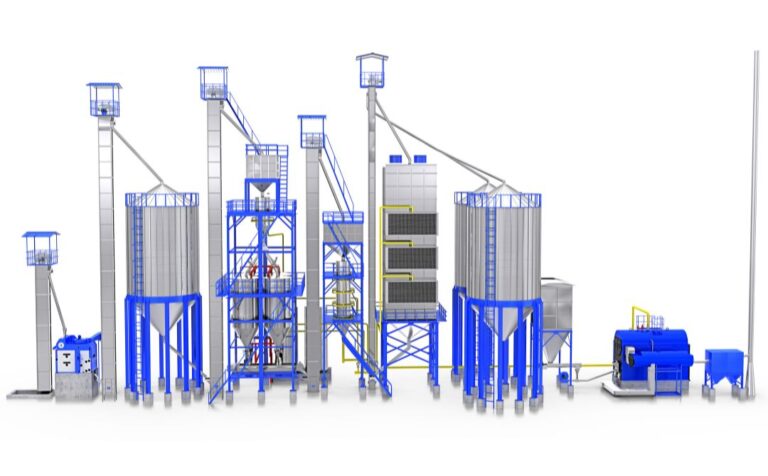Table of Contents
In the heart of India’s rice belt, where paddy fields stretch across vast landscapes and sustain millions of livelihoods, the art of parboiling has evolved from age-old traditions to a sophisticated process that enhances grain quality and nutritional value.
Parboiling of paddy by simple soaking in hot water represents a streamlined approach that balances efficiency with the preservation of rice’s inherent benefits, making it a cornerstone of modern rice processing.
At SKF Elixer, we specialize in paddy parboiling plants that integrate this method with precision engineering, empowering rice manufacturers to produce superior parboiled rice while minimizing energy use and waste. Our systems are crafted to meet the demands of India’s diverse rice varieties and climates, ensuring consistent results for both small cooperatives and large-scale operations.
This blog uncovers the essence of parboiling paddy through hot water soaking, its step-by-step process, and the transformative effects on rice quality. Whether you’re a rice mill owner in Tamil Nadu, a farmer in Uttar Pradesh, or a processor in West Bengal, understanding this method will help you optimize your operations for better yields and market appeal.
Understanding Parboiling of Paddy
Parboiling is a hydrothermal treatment that partially cooks paddy in its husk before milling, involving soaking, heating, and drying to gelatinize starch and drive nutrients from the bran into the endosperm. The simple soaking in hot water method, a variation of traditional practices, focuses on immersion in heated water without steaming, offering a cost-effective alternative for small to medium-scale rice plants. This approach achieves about 30% moisture uptake (wet basis) while avoiding over-soaking, which can cause husk splitting or leaching.
In India, where parboiled rice accounts for approximately 60% of consumption, this method is particularly valuable. It produces parboiled rice that is firmer, less sticky when cooked, and richer in vitamins like thiamine, making it a staple in households across the country.
SKF Elixer’s paddy parboiling plants automate this process, handling 3–15 tonnes per hour, ensuring uniform treatment and reducing labor by 50%, which translates to ₹1–2 lakh annual savings for a medium-sized mill processing 50 tonnes daily.
What Is Parboiling of Paddy by Hot Water Soaking?
Parboiling by hot water soaking involves immersing clean paddy in water heated to 70–85°C, allowing controlled moisture absorption to gelatinize starch without the need for separate steaming. This method, rooted in ancient Indian practices but refined for modern rice plants, typically takes 1.5–2 hours for soaking, followed by tempering for 1–2 hours to distribute heat evenly. The result is paddy with 30% moisture, ready for drying to 12–14%.
Unlike cold soaking, which takes 2–3 days and risks microbial growth, hot water soaking accelerates the process while inactivating enzymes and preserving nutrients. For rice manufacturers, this means producing parboiled rice with enhanced milling yield (up to 70%) and reduced breakage (below 5%), compared to 50–60% yield in raw rice. SKF Elixer’s plants use temperature-controlled tanks to maintain 70–80°C, ensuring optimal gelatinization without over-imbibition, ideal for varieties like Basmati or Sona Masuri.
Step-by-Step Paddy Parboiling Process
The parboiling process in plants follows a precise sequence, optimized for efficiency and quality:
1. Pre-Cleaning and Preparation
Paddy is first cleaned to remove impurities like stones and dust (1–2 kilograms per tonne), using vibratory sieves and air aspiration. This step, handling 5 tonnes per hour, prevents contamination and ensures even soaking, saving ₹5,000–₹10,000 per batch in potential losses from defective grains.
2. Hot Water Soaking
Clean paddy is immersed in hot water at 70–85°C in stainless steel tanks, with a paddy-to-water ratio of 1:2.5. Soaking lasts 1.5–2 hours, achieving 30% moisture uptake. The water is circulated to maintain temperature, promoting uniform absorption without leaching. For a 10-tonne batch, this step gelatinizes starch, enhancing nutrient migration and saving 20–30% time compared to cold methods.
3. Draining and Tempering
Excess water is drained, and paddy is tempered for 1–2 hours at 60–70°C to allow heat to penetrate the core, avoiding ‘white belly’ defects in rice. This resting period distributes moisture evenly, improving milling quality by 10–15%.
4. Drying
Tempered paddy is dried to 12–14% moisture using integrated dryers at 40–50°C, taking 6–8 hours per batch. SKF Elixer’s systems use husk-fired furnaces, consuming 50–100 kilograms of husk (₹500–₹1,000 per tonne), ensuring uniform drying and 95–97% head rice recovery.
5. Milling and Storage
Dried parboiled paddy is milled, yielding 65–70% rice with minimal breakage. The process boosts storage life to 12–18 months, reducing losses by ₹20,000–₹30,000 per tonne.
This integrated process in SKF Elixer’s plants processes 3–15 tonnes per hour, with automation reducing labor costs by ₹1–2 lakh annually for a 50-tonne-per-day operation.
Rice Parboiling Methods
Several methods exist, but hot water soaking stands out for simplicity:
- Cold Soaking: Traditional, 2–3 days at ambient temperature, risks fermentation and off-flavors.
- Hot Water Soaking: Modern variant, 1.5–2 hours at 70–85°C, faster and nutrient-preserving.
- Steam Parboiling: Involves pressure steaming, effective but energy-intensive (₹2–3 lakh annual fuel costs for 50 tonnes/day).
- Pressure Parboiling: High-pressure steaming for quick gelatinization, suited for large rice plants but costs high for setup.
SKF Elixer’s plants favor hot water soaking for its balance of cost and quality, adaptable for small rice manufacturers.
Benefits of Parboiling Paddy
Parboiling by hot water soaking yields multiple advantages:
- Nutritional Enhancement: Drives thiamine and other vitamins from bran to endosperm, retaining 80–90% nutrients post-milling, unlike raw rice’s 50–60% loss.
- Improved Milling Yield: Increases yield to 65–70%, reducing breakage to below 5%, saving ₹10,000–₹20,000 per tonne.
- Better Grain Quality: Gelatinized starch makes rice firmer, less sticky, and faster-cooking (15–20 minutes vs. 25–30 for raw), appealing to consumers.
- Extended Shelf Life: Inactivates enzymes, preventing rancidity and insect damage, extending storage to 12–18 months.
- Economic Gains: Higher market price (₹5–10 more per kilogram) adds ₹25 lakh–₹50 lakh annually for a 50-tonne-per-day mill.
For rice manufacturers, this method boosts profitability while meeting FSSAI standards. Read more about the nutritional and economic benefits of paddy processing.
Traditional vs Modern Parboiling of Paddy
Traditional parboiling relies on manual soaking in earthen pots for 2–3 days at ambient temperature, followed by open steaming and sun-drying. This labor-intensive process (₹50,000–₹1 lakh annual labor costs for 50 tonnes/day) risks uneven gelatinization, leading to 10–15% breakage and nutrient loss.
Modern methods, like SKF Elixer’s automated hot water soaking, use controlled tanks for 1.5–2 hours at 70–85°C, followed by mechanical drying. This reduces time by 80%, breakage to below 5%, and energy use by 30–40% (₹1–2 lakh savings annually). Modern systems also minimize leaching, preserving color and taste, making parboiled rice more marketable.
How Does Hot Water Soaking Affect Rice Quality?
Hot water soaking at 70–85°C gelatinizes starch without over-imbibition, enhancing kernel hardness and milling yield by 10–15%. It drives nutrients inward, retaining 80–90% thiamine, and inactivates lipases, preventing rancidity. However, excessive temperature (>85°C) causes discoloration or splitting, reducing whiteness score by 5–10 points.
Tempering post-soaking ensures even heat distribution, improving texture and reducing ‘white belly’ to below 2%. Overall, this method produces parboiled rice with superior cooking properties like firmer texture, lower stickiness, and better digestibility, fetching ₹5–10 more per kilogram.
In SKF Elixer’s plants, precise controls maintain optimal conditions, ensuring high-quality output for premium markets.
SKF Elixer’s Paddy Parboiling Plant Solutions
Our paddy parboiling plants are designed for efficiency:
- Small-Scale Units: 3–5-tonne-per-hour systems suit cooperatives in Bihar, saving ₹1–2 lakh annually in labor and losses.
- Medium-Scale Plants: 10–15-tonne-per-hour setups process 200–300 tonnes daily, boosting yields by 10–15% for mills in Tamil Nadu.
- Integrated Systems: Combine soaking, tempering, and drying, reducing energy by 30%, with AMCs ensuring 98% uptime.
Why Choose SKF Elixer?
With years of pioneering expertise, SKF Elixer delivers BIS-certified parboiling plants tailored for Indian varieties. Our options and support make modernization accessible, enhancing rice quality and profitability.
Conclusion
Parboiling by simple hot water soaking elevates paddy processing, delivering nutritious, high-quality parboiled rice with economic benefits. SKF Elixer’s automated plants streamline this process, reducing costs and improving yields for rice manufacturers across India. Embrace this method to transform your operations.
Ready to optimize your parboiling process? Contact SKF Elixer to explore our paddy parboiling plant solutions.
FAQs
-
1. What is parboiling of paddy by hot water soaking?
It involves immersing clean paddy in 70–85°C water for 1.5–2 hours to achieve 30% moisture, followed by tempering and drying. This gelatinizes starch without steaming, improving nutrient retention and milling yield to 65–70%.
-
2. What is the step-by-step paddy parboiling process?
Clean paddy (remove 1–2 kg impurities per tonne), Soak in 70–85°C water (1:2.5 ratio, 1.5–2 hours), Drain and temper (1–2 hours at 60–70°C), Dry to 12–14% moisture (6–8 hours), Mill for 95–97% head rice recovery.
-
3. What are the advantages of simple soaking in hot water for parboiling rice?
It accelerates moisture uptake (30% in 1.5–2 hours), retains 80–90% nutrients like thiamine, reduces breakage to below 5%, and saves 80% time vs. cold soaking, adding ₹5–10 per kg market value.
-
4. How does traditional vs modern parboiling of paddy differ?
Traditional uses ambient soaking (2–3 days), risking fermentation and 10–15% breakage (₹50,000–₹1 lakh labor costs). Modern hot water soaking (1.5–2 hours) ensures uniform gelatinization, 95–97% yield, and 30–40% energy savings.
-
5. How does hot water soaking affect rice quality?
It gelatinizes starch for firmer texture, drives nutrients inward (80–90% thiamine retention), reduces stickiness, and extends shelf life to 12–18 months, but requires control to avoid discoloration (whiteness score drop of 5–10 points if >85°C).
Good reads are meant to be shared









